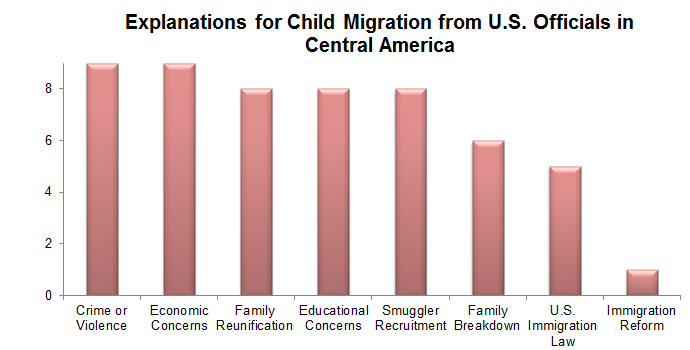As the House Judiciary Committee moves to markup two bills meant to prevent a repeat of the surge of child migrants over this summer, the Government Accountability Office (GAO) released a report on what U.S. officials stationed in Central America see as the factors behind the border rush. The results suggest that the majority of these officials agree with most analysts in the United States – including myself. To wit, the influx is mainly a consequence of violence, economic conditions, and a desire for family reunification in the United States. U.S. immigration policy plays only a secondary role.
While some outlets have erroneously reported that these are GAO’s conclusions, the GAO is simply reporting the opinions of nine U.S. officials (three ambassadors, three mission directors for USAID, and three country attachés for the Department of Homeland Security in El Salvador, Guatemala, and Honduras). “Agency officials reported drawing on various sources of information to identify these causes,” the report states, “ranging from conducting first-hand interviews to analyzing various statistical data.”
Agency officials cited violence, economic conditions, or both as the primary factors driving emigration in each of the three countries.
- All nine officials reported that violence and poverty were a motivation for migrants to head north.
- Eight of nine reported that a desire for better education, the desire join to families in the United States, and recruitment by smugglers all played a significant role.
- Domestic abuse and family breakdown was cited as a factor by two thirds of the officials surveyed.
- Although not in the top five most commonly cited factors, U.S. immigration policy was also cited as an emigration driver by five officials.
- Additionally, Honduran officials told the GAO that many children had left to reunite with family that had fled during the political crises in the country in 2009 and 2010.
These factors are largely consistent with those that I reported in my analysis of the impact of the Deferred Action for Childhood Arrivals (DACA) program on the child migrant crisis. U.S. immigration law primarily encourages Central American children to enter illegally due to the likelihood that they will be quickly reunited with their family in the United States while waiting for a long-delayed removal proceeding. The report states that “some Hondurans believe that unaccompanied children would be reunited with their families and allowed to stay in the United States,” which is true. Otherwise, the main factors that I listed were economic concerns, violence, family reunification, and smuggler recruitment.
While some have already sought to use the GAO report as an argument against immigration reform, only one official out of the nine cited amnesty for illegal aliens—specifically within the context of a comprehensive immigration reform bill (presumably the Senate’s 2013 bill)—as a motivating factor for some Hondurans in the border rush.
The most important point, however, is that nothing in the GAO report supports the oft-cited contention that Central American children were responding to the president’s executive actions (primarily DACA) to provide for the more targetted enforcement of immigration laws.
